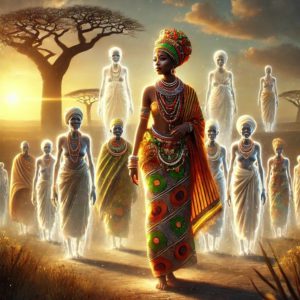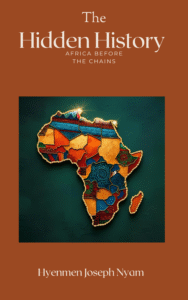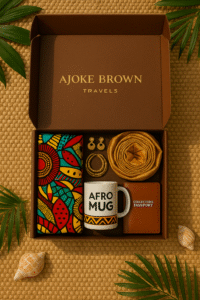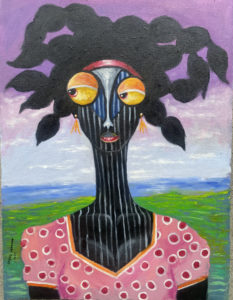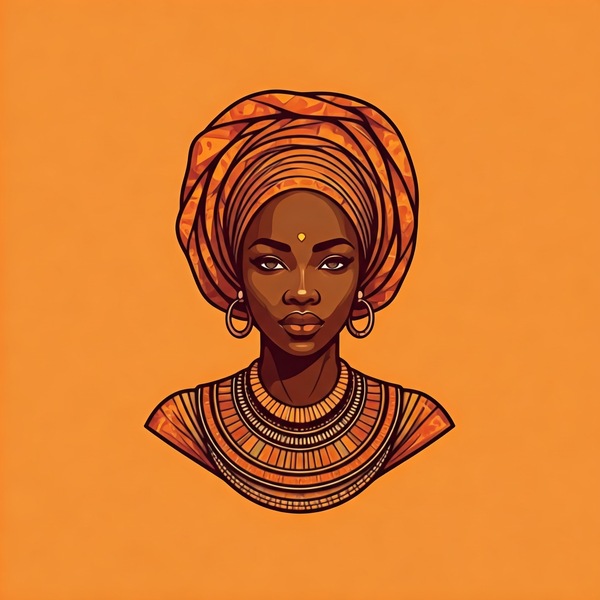Figures, Faces, and the Stories Between: Meet Okeke Uchenna Victor

Okeke Uchenna Victor transforms the everyday into extraordinary through his mastery of acrylics and oil, every brushstroke tells a story. Okeke Uchenna Victor blends contemporary vision with the timeless rhythms of African culture, bringing figures to life with line, texture, and color. His paintings invite you to witness emotion, identity, and the hidden narratives that pulse through daily life, making the ordinary feel profoundly universal. Drawing on African traditions, from Igbo masquerades to Oriolokun sculptures he explores the human figure with a focus on the eyes, the windows to the soul. Each piece challenges viewers to pause, reflect, and connect with the subtle poetry of life.

Can you describe your creative process from initial concept to the final piece? Are there any rituals or routines you follow?
My creative process often begins with observation watching everyday life and noticing beauty in the ordinary. I allow inspiration to guide me, whether it’s a fleeting moment, a memory, or a traditional form. I usually start with rough sketches or outlines, exploring lines, forms, and textures. From there, I build layers, playing with color and medium until the piece feels alive. I don’t have strict rituals, but I often spend quiet time reflecting on my concept before touching the canvas, as if tuning myself into the essence of what I want to express.
What materials, techniques, or mediums do you work with, and how do they help you express your vision?
I work with whatever medium I can find, though I am most drawn to acrylics and oil paints. Each medium has its own character: acrylics allow me to experiment quickly and layer boldly, while oils give depth and richness that enhance the emotional resonance of the figure. I love painting the human form because it allows me to twist and reshape reality to match my perception. I often focus on the eyes, they are a portal to the soul and capture the essence of the human experience.
How has your artistic style evolved since you first started, and what pivotal moments or influences shaped these changes?
My style has matured through years of experimentation and deep engagement with both contemporary life and traditional African art. Early on, I painted instinctively, but over time I’ve become more intentional in exploring form, texture, and narrative. Key influences include the Oriolokun sculptures and the Igbo dance masquerade, Okunkor, which taught me the power of symbolism, rhythm, and movement. These experiences helped me blend figurative representation with abstract elements, giving my work a layered, expressive quality.
How do you balance tradition and innovation in your work, especially when drawing from the rich African artistic heritage?
I see tradition not as a limitation but as a springboard for innovation. I draw inspiration from historical carvings, masks, and ceremonial art while translating them into contemporary contexts using modern techniques and mediums. I play with lines, forms, and textures to create pieces that honor African heritage while inviting viewers to see it in a new light. It’s about dialogue between the past and the present, tradition and personal expression.
Which emerging or historical African artists do you find particularly compelling or inspiring right now?
I am inspired by artists who explore identity, culture, and the human form with bold vision. Historically, the works of Ben Enwonwu and Twins Seven-Seven resonate deeply, while contemporary figures pushing boundaries in figurative and mixed-media work also influence me. Their dedication to preserving cultural narratives while innovating within their medium reminds me of the importance of both heritage and personal voice.

What challenges and triumphs have you encountered as an artist working within or representing the African continent?
One challenge has been navigating the limited platforms and exposure available for African artists, which requires persistence and self-promotion. However, each exhibition, commission, or viewer connection feels like a triumph, proof that African art is not only vibrant but universal in its appeal. Representing our stories and aesthetics is both a responsibility and an honor.
How do you engage with your audience and what message or emotion do you hope to evoke through your work?
I engage with my audience through exhibitions, social media, and conversations about the themes in my work. I aim to evoke empathy, introspection, and a sense of shared humanity. By focusing on the human figure and its eyes, I hope viewers connect with the inner life of the subjects and reflect on their own experiences. I want my work to be a mirror that invites emotional and cultural reflection.

What role do community and collaboration play in your artistic journey, if any?
Community has always been important in my journey. Learning from fellow artists, participating in group exhibitions, and drawing from communal traditions strengthens my perspective and fuels creativity. Collaboration opens new avenues of experimentation, whether through shared projects, mentorship, or cultural exchanges, and helps my work resonate beyond my individual vision.
What are your future aspirations for your art, both in terms of projects and wider reach?
I aspire to continue exploring the human figure and African heritage while expanding into larger-scale projects and international exhibitions. I want to collaborate with cultural institutions and create works that spark dialogue about identity, tradition, and contemporary life. Ultimately, I hope my art reaches a global audience while remaining deeply rooted in African experiences and aesthetics.

How can your art be purchased or commissioned?
My art can be purchased directly through my exhibitions, online platforms, or private commissions. I welcome inquiries for custom pieces that allow clients to collaborate with me on concepts and mediums. Each work is a unique expression, tailored to capture both my vision and the narrative envisioned by the client.




